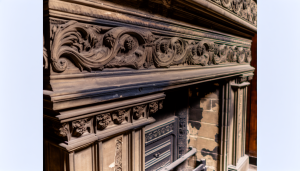What is an ethical chair? What gives a chair its “chairness”? Gustav Stickley pondered such things and led us to modern aesthetics.
By Kerry Lange
You know Gustav Stickley. You’ve brushed past him many times. He winks through contemporary architecture. He’s the naked grain and natural shapes of Danish furniture; the chrome tubular framed chairs; the long, low-slung coffee tables; the minimalist design; the rectilinear patterns in modern furniture and buildings — they all speak Stickley. Still, the man escapes.
Gustave Stoeckel (later Americanized to “Stickley”) was born in Wisconsin to an immigrant German family and grew up in the midst of the state’s large German population. He knew hard work, penury, and family hardship.
Stickley’s stonemason father, Leopold, introduced Stickley to his craft. Stickley was skilled enough to earn journeyman’s wages by the time he was 12. He hated it.
It was heavy and tedious labor, much too hard for a boy of my age, and being put to it so early gave me an intense dislike for it. Had I been older and stronger, I might not have realized so keenly its disagreeable features, but as it was, the feeling of the lime and the grinding of the trowel over stone and mortar was especially repugnant to me, and the toil itself meant the utmost physical strain and fatigue.
Perhaps Stickley’s father shared his dislike for stone masonry. Deep-seated unhappiness and alcohol made Leopold unreliable and young Stickley became the main family provider. Consequently, it was difficult and impractical for Stickley to get an education beyond the eighth grade. With little school-fed knowledge, he found other fuel for his imagination. Stickley discovered Emerson and John Ruskin who, along with William Morris, would later fire his imagination to its brightest.
In the early 1870s, depression and alcoholism drove Leopold to leave his family. By 1875 Barbara, Stickley’s mother, moved the fatherless family to Laynesboro, Pennsylvania to live with her brother, Jacob Schlaeger. Schlaeger owned a small furniture factory in Brandt. It was there that Gustav Stickley first worked seriously with furniture and wood.
Looking back, his father’s abandonment was a backhanded blessing. Stickley, primed by hardship, the necessity of hard work and stern independence, was now free of the trade he hated so much.
He spent 1875 to 1883 absorbing millwork, manufacturing, management and business. During this time he became a manager at his uncle’s company, a rise that had less to do with nepotism than the ability to manage a factory that churned out 96,000 chairs a year.
Stickley took another pivotal step in 1883 when he went into business with his brothers Albert and Charles. A year later the brothers started retailing their furniture.
The phrase “does not play well with others” comes to mind early on with Stickley, and it was no different with his brothers. Stickley broke with a lot of partners through his career; perhaps his independent spirit chaffed at work and compromised with others. Whatever the reason, Stickley left his brothers and in 1888 went into business with Elgin A. Simmons. By 1890 the Stickley and Simmons Company opened an office in Auburn, New York and by 1895 the company built a new factory near Syracuse in Eastwood, New York.
Stickley’s furniture was generally well received at this point, but it failed to stand out. They produced popular colonial revival pieces and furniture received run-of-the-mill machine-made “gingerbreading.” Still, Stickley and his partner knew their market and their business. The company grew and gained important contracts and, eventually, raised its profile above the manufacturing milieu.
But something bubbled beneath the surface. Stickley wrote:
At first, in obedience to the public demand, I produced in my workshops adaptations of the historic styles, but always under silent protest: my opposition developing … I resent these imitations which could not preserve a spark of the spirit, the vivacity, the grace of their originals.
In 1895 and again in 1896 Stickley traveled to Europe. Fed by his new experiences his imagination smouldered.
[F]or the first time, I saw the French styles in their proper surroundings, acting as integral parts of palace architecture … precisely as specimens once having had organic life, are classified in a Museum of Natural History.
Here, Stickley saw the writings of Ruskin and Morris transformed into furniture, buildings, art and communities: Arts and Crafts. He saw what “honest” and “pure” craftspeople wrought with their minds and hands. He saw his English contemporaries shaking tradition and creating a new style fit for the times — indigenous to their own modern culture.
During and after these visits Stickley likely ruminated about an American style — asking what American “honesty,” “purity,” “simplicity,” and beauty look like. What is the indigenous American modern style? What would uplift and improve people when they looked at it? In short, Stickley sought the ethical chair.
Stickley drew from the Shakers who made simple, functional furniture. He also drew on his roots in prairie and frontier log homes, Californian architecture and aesthetics and American native art. He was also well aware of the movement toward “the simple life.”
In 1898, Stickley knew he couldn’t compromise with his partner anymore. He called a board meeting, failed to invite Simmons, and forced him out of the company. Not long afterward, he formed the Gustav Stickley Company.
Stickley’s imagination percolated. He spent years making prototypes. In 1900, he announced his line of “New Furniture,” displayed at the Grand Rapids exhibition in July. To Stickley, industrial was about artifice and show — a way to make money. He wanted his new furniture to be about art and purpose.
He crafted each component according to function and place. Mortise & tenon was a feature. Dovetail was decoration. Design was structural. Thick, simple and straightforward lines made Stickley’s pieces look like they were from the middle ages — and could last hundreds of years more.
The vital quality of primitiveness does not imply crudeness … the primitive form of construction is the form that would naturally suggest itself to a workman as embodying the main essentials of a piece of furniture, of which the first is he straightforward provision for practical need. So … I turned all my attention to making plain furniture … of strength, durability, and comfort…
Stickley renamed his company United Crafts, drawing parallels to the mediaeval guilds that inspired his early work. But, still his imagination burned.
Stickley pushed Arts and Crafts forward. Ruskin believed things must be made by hand — true craftsmanship precluded the use of machinery. But Stickley, so familiar with woodworking machinery, couldn’t reconcile Ruskin’s theories with modern life. Machinery could help people achieve better work. Where the use of machines went wrong, he felt, was in the thoughtless reproduction of historical pieces.
In ninety-nine cases out of a hundred, the inventor of a machine … is himself a master of that work and has turned his ability toward the finding of some means by which it may be more perfectly, as well as more easily done. When rightly used, that machine is simply a tool in the hands of a skilled worker…
People could be artisans using machinery. They could achieve fulfillment and joy working with machines.
In 1901, he saw the need to found his own magazine, The Craftsman. Stickley dedicated the first issue to William Morris, father of the English Arts and Crafts movement. The Craftsman featured his furniture alongside items that complemented his work. As such, The Craftsman served to popularize all things Craftsman.
Ironically, though Stickley was “editor” of The Craftsman, he was not a skilled writer. With his limited education, Stickley had little opportunity to develop as a writer. Letters he wrote to family members late in his life illustrate this undeveloped skill. Though filled with obvious care and affection, they also belie his humble start in life. However, writing was never a problem: In the early years of The Craftsman, Irene Sargent ghostwrote for Stickley. In later years, Mary Fanton Roberts took on the task of bringing Stickley’s words to life.
Architect Harvey Ellis joined Stickley in 1903. Ellis, a relatively unknown architect, moved Stickley’s designs toward “Standard Stickley.” Ellis introduced lighter components and lines to Stickley’s furniture along with features more common to Art Nouveau and English Arts and Crafts designs. But instead of using the whiplash curves of Art Nouveau, or acting as blatant decoration, as in English Arts and Crafts, Ellis’s designs used inlaid material to reduce monotony and draw the eye to structural elements.
Ellis also had a profound effect on The Craftsman. His covers and illustrations are among the best the magazine featured. Ellis drew both The Craftsman and Stickley’s designs away from Medievalism and toward the elegant but prosaically simple, “Standard Stickley.”
Ellis died in 1904 after working only 10 months with Stickley. Ellis’s influence on the magazine and furniture faded, but his lighter furniture lines and components stayed with Stickley.
Shortly after Ellis’s death, Stickley traveled to California and connected with many Arts and Crafts followers and, as a result, wrote about creating a utopian Arts and Crafts community in the west. Though the western movement came to nothing, it lead to his New Jersey project: The Craftsman Farms.
Flush with the success of his furniture and designs and backed by more money than a Wisconsin farm boy could imagine, everything flowed together. All he had to do was build it; the ideal farm, the ideal home, ideal furnishings, ideal philosophy, community, and family.
At the Craftsman Farms Stickley practiced his Arts and Crafts philosophy — in doing so he spent enormous amounts of money. He proposed the model Arts and Crafts community; there, industrious craftspeople would tend fields, raise livestock, and make and enjoy beautiful things. His search for the ethical chair would yield the ethical life.
At first, his family lived in the building meant as the clubhouse and his daughter and son-in-law lived in one of the two cottages Stickley built. He hired people to look after the farm and enjoyed working it himself before he took the morning train to work. But it only lasted until 1916, unable to thrive after his Craftsman enterprise collapsed. He never completed the farm.
Though the Craftsman Farms required fortune to build homes and cottages and buy land, seed and animals — the real money went into his 13-storey Craftsman Building. Leased in 1913, the building committed Stickley to the hefty sum of $1,500,000 over five years.
At first glance the Craftsman Building seems like a compromise with Stickley’s Craftsman ethics. After all, here was The Craftsman, who railed against thoughtlessly mass-produced products, mass-marketing his factory-made wares to the public. Yet, Stickley viewed the Craftsman Building as the culmination of his philosophy. His products were thoughtfully designed and manufactured. He wanted to surround others with what he saw as honest and ethical — the more people reached, the better.
The Craftsman Building had everything you could need for creating a home. You could meet with an architect on an upper floor, browse building materials on another, shop for furniture lower down, look through accessories, or have a meal on the top floor. Looking back, it’s easy to see how Stickley’s concept could work. Home Depot and Rona can attest to the concept of one store for everything. But as profitable as his furniture business was, it couldn’t support the Craftsman Building. In 1914, when the First World War began, credit tightened, as did pocketbooks. Combined with changing tastes and the huge financial burden of his building, Stickley’s fortunes shrank.
He was forced into bankruptcy in 1915 and had to sell his beloved Craftsman Farms the next year. After bankruptcy, Stickley never attempted a comeback. He dabbled in toy manufacturing, consulting and furniture finishes until his death in 1942, but never at the same scale as before his bankruptcy.
Whatever the end, Gustav Stickley changed us. We can see his fingerprints on steel framed chairs with leather strung backs and seats, cube chairs, expansive spaces defined only by their shape, and minimalist design.
In the shapes we use and see every day we can see the Wisconsin farm boy and the ethical chair.






